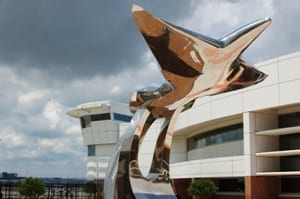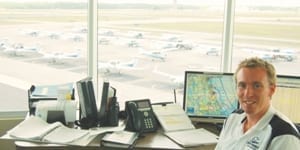Embry-Riddle: Climbing out despite turbulent times
Check out their line of headsets, camera cables, and LED lighting today!
You might wonder how a big aviation university is doing during the recession. After all, airline flying is not the glamorous, big money career it used to be. What’s a college to do? At Embry-Riddle Aeronautical University in Daytona Beach, Florida, change is the order of the day.

That change has been underway for some time under President Dr. John Johnson. Academics (and academic reputation) are top priority as ERAU augments its well-known role in professional pilot training. That transition is now dramatically symbolized by a bold new building program, as I saw with some top university officials early this summer.
Genesis for re-building was another type of turbulence – not the nation’s economic crisis but a Christmas Day, 2006, tornado that swept through campus. Major buildings were damaged or destroyed. Now, a grand promenade leading to three new buildings of the James Hagedorn Aviation Complex approximates the 2006 tornado’s path. Amid 99,000 square feet of new instructional space is a stunning metal sculpture of flight, “Pathways to the Sky,” by artist Peter Forster (left).
Surrounding it are the new maintenance hangar, aviation maintenance science building and Flight Operations building. Inside the latter, flight planning and dispatch is a modern vision of the future, including flat-screen displays and computerized pilot self-briefing stations.
ERAU is heavily involved in NextGen. The FAA’s Florida NextGen Test Bed is there. Students and managers can see – in real time — the disposition of flights in all university training areas. All ERAU aircraft have been equipped for ADS-B “in and out” since 2003. Plots of any training flight can be played back for post-flight critique.

Part of Embry-Riddle’s training fleet as seen from the new ramp tower on campus
Elsewhere, the depth of ERAU’s maintenance curriculum is illustrated by a nifty jet engine lab with a score of jets from ancient to recent. Each year, students take ‘em apart and put ‘em back together, hands-on. Examples go way back to Westinghouse J-34s and a German Junkers Jumo – real lessons in the development of the jet. Nearby, as part of ERAU’s meteorology major, there’s even a television studio for training future TV weather people.
Anticipating changes in the pilot profession, the university now offers a major in Unmanned Aerial Systems. Included are eight ground control stations providing 16 training positions for UAV pilots and sensor operators. General Atomics, the original UAV pioneer under ex-Beech president Linden Blue, hires several ERAU graduates annually.
On the purely academic side, the university also boasts a major authority on space ports and space aviation law as space tourism gears up. ERAU’s proximity to the Kennedy Space Center has always been an advantage and an inspiration. Now, there’s a shuttle runway down there begging for new uses.
Riddle’s 1,477 flight students (as of year-end, 2011) may be the university’s best-known product, but ERAU’s fast-growing aerospace engineering program was again crowned best-in-the-nation among its peers by U.S. News and World Report — for the 13th straight year. Mechanical and general engineering also rank in the top 10, or nearly so. Among other programs to watch: a new degree in cyber security at a Global Security and Intelligence Studies program on the Prescott, Arizona, campus.
There’s lots going on, as represented by all the construction on the Daytona campus. A new 35,000-square-foot administration and welcome center is replacing tornado-ravaged Spruance Hall. A new College of Arts and Science building will host human factors and systems, humanities and social sciences, mathematics and the physical sciences (replete with a new astronomy program and Florida’s largest university telescope.) Most ambitious is a 90-acre research park on land just south of campus. It could host 2,000 hi-tech jobs when built-out in 10 years. A new 100,000-square-foot student union is also due by 2015.
With all that’s going up, some things come down. Not missed by many are the iconic, squat hexagonal brick buildings of 1969 vintage and notoriously odd design mandated by equally iconic 1963-1984 ERAU president Jack Hunt. (Their multi-faceted shape, with outside entry for each ground floor classroom, trimmed space required for interior hallways.) They were a welcome pile of rubble by May this year as shining, tall modern buildings took their place.
Embry-Riddle is responding to the change that challenges us all in aviation. Research and Development (R+D), 70% funded by private industry/government partners, has doubled to $15 million in five years. Stronger academic programs make ERAU more attractive regardless of the pilot hiring cycle. Although the cost of pilot training plus academic degree still raises eyebrows, Embry-Riddle pilots are acknowledged to be professionally trained. Recently, ASA and Delta established a special program to hire ERAU grads.
Many, many grads have gone far in our world. Some have even left it behind. Colonel Ronald J. Garan, Jr. recently spent 178 days aboard the International Space Station. Daniel Burbank flew aboard the ISS after Garan. The U.S. astronaut corps has included six ERAU alumni, counting “Worldwide Campus” grads of military base extension programs. The university boasts that 21 of the biggest names in aviation – from Boeing to Southwest to Cessna — employ 100 or more grads each. Boeing employs nearly 4,000.
Embry-Riddle has come a long way — from a 1926 two-Jenny flying school at Cincinnati’s Lunken Field to its massive World War II pilot training programs in Florida to its mid-1960s move from Miami to Daytona Beach. And despite the uncertainty of today’s aviation world, ERAU continues to evolve and adapt.
Article found here: http://www.generalaviationnews.com/2012/10/08/embry-riddle-climbing-out-despite-turbulent-times/
We would love to see your comments below.
VISIT OUR SPONSOR for Training DVD's, affordable headsets, cable adapters, headset parts, LED strobes and lights, and more! They cover ALL EXPENSES for iFLYblog.com to keep it coming FREE to you FOREVER!
Subscribe to the iFlyBLOG Mailing List to get the latest blog posts and news to your E-Mail instantly! PLUS TWO FREE eBooks!



Very interesting to read about the growth of ERAU. I thought about going to ERAU in the mid 80’s. Because it was out of state, my parents talked me out of it. I went to the Air Force instead and still went to school out of my home state but because of the military assignment, I was able to get in state tuition. In hindsight, I could have worked my way to FL or AZ, one way or another and attended ERAU. I’ve met several ERAU grads. Much has been talked about “what you get for your money” at ERAU. In the end, I don’t think there is any education system like ERAU so focused on a particular field of study. Reading your post, it is clear, the university has leadership to ensure they are built to last. I imagine what students get from ERAU is something you can’t put a price on – the experience of being around so many like minded individuals. I don’t make my living in aviation anymore but often think it may have been a result of a solid bond not being set during those formative college days. It is true – follow your passion and your other needs will be taken care of.
Riddle is a good school, graduated from Prescott. The real bummer is tution is getting extreamly expensive. 100k + in student loans is not uncommon for even non-flight students.